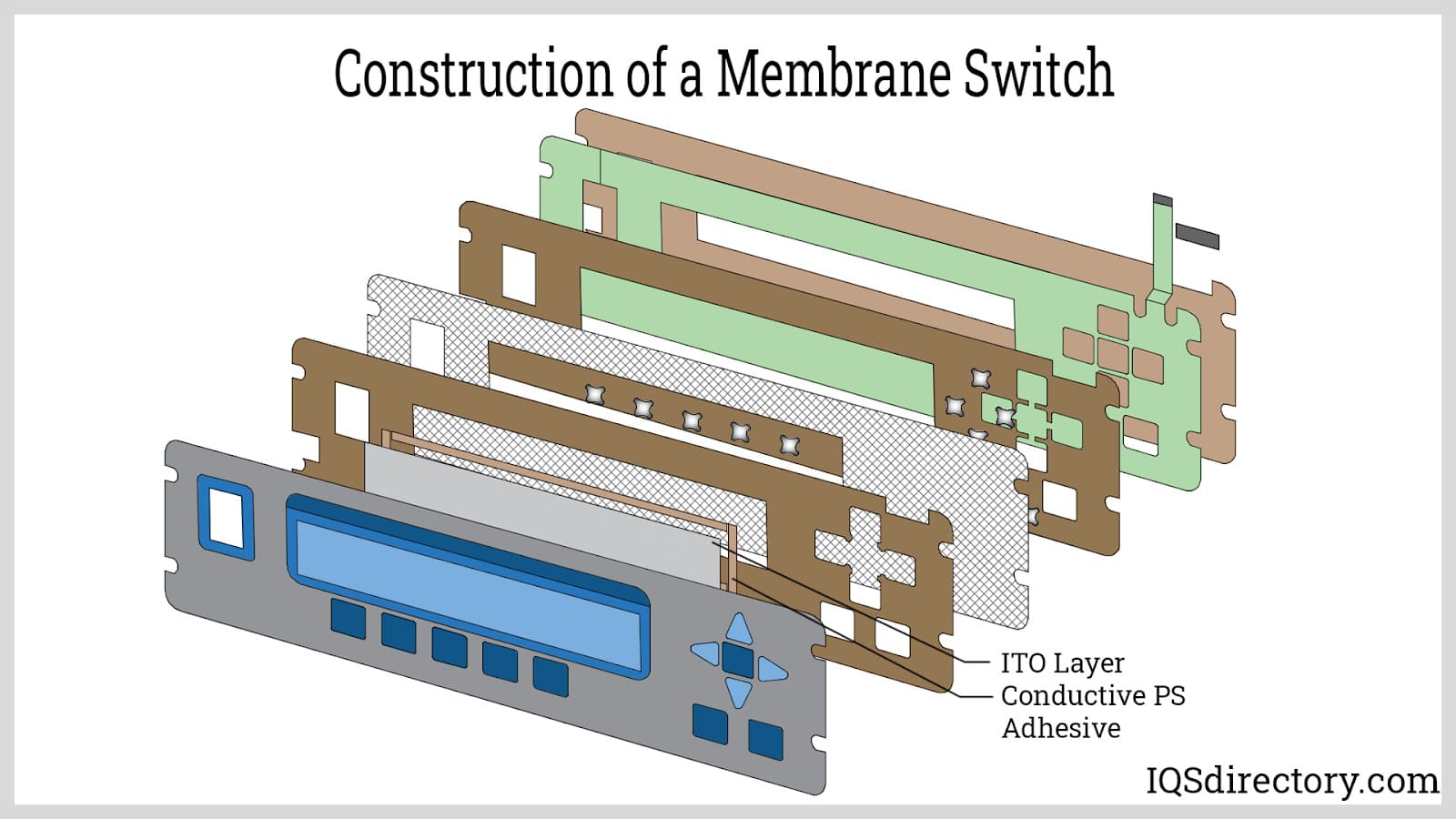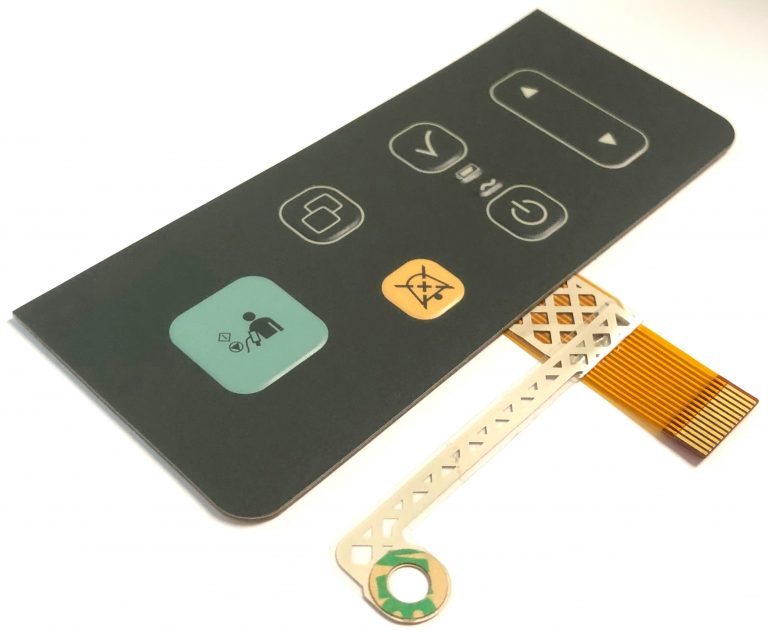Everything you need to know about membrane switch customization
The Manufacturing Refine Behind Membrane Switch Over: What You Need to Know
The production procedure behind membrane layer switches combines mindful design, product selection, and top quality control. It begins with understanding the details of membrane button design and proceeds through numerous stages, consisting of material selections and printing techniques. Each stage plays a vital duty in making sure functionality and toughness. The complexities of layer building and construction and the rigorous testing criteria might reveal insights that are not promptly apparent. What lies past these fundamental elements?
Understanding Membrane Change Layout
Although membrane layer buttons might show up simple at very first glimpse, their layout entails intricate considerations that assure capability and durability. The style process starts with a detailed understanding of customer needs, consisting of the user interface's desired application and ecological variables. Ergonomics is a crucial component, as the format has to promote convenience of usage while making sure that responsive responses fulfills customer expectations.Moreover, the layering of elements, such as graphic overlays, sticky layers, and conductive traces, should be precisely engineered. membrane switch. This split arrangement not just influences the button's responsiveness however additionally affects its durability. Focus is provided to the securing methods employed to shield versus wetness and dust, which can compromise efficiency. In addition, style considerations encompass appearances, where color design and visual quality improve user experience. Ultimately, the layout of membrane switches over equilibriums functionality, user experience, and resilience, making sure that they satisfy the needs of different applications effectively
Products Used in Membrane Layer Change Manufacturing
When picking materials for membrane layer switch manufacturing, it is important to contemplate both efficiency and sturdiness. The main materials include polyester and polycarbonate movies, which give versatility and toughness. These movies are usually covered with sticky to guarantee proper bonding to substratums. Conductive inks, commonly composed of silver or carbon, are crucial for developing electrical links within the switch, permitting reputable operation.Additionally, a safety layer, such as a hard coat, is regularly related to enhance scratch resistance and long life. The choice of backing material, such as acrylic or foam, can substantially impact the switch's responsive feeling and total customer experience. Different environmental aspects, including temperature level and moisture, should direct product option to assure peak efficiency in details applications. Ultimately, the ideal mix of products adds to the membrane layer button's capability and lifespan, making informed options vital for makers.
The Printing Refine: Creating Video and Text
The printing procedure in membrane layer button manufacturing plays a substantial function in creating top notch graphics and message. Numerous visuals style methods are utilized to ensure visual appeal and functionality, while careful ink selection methods are essential for durability and performance. Recognizing these components is basic for accomplishing finest results in membrane button style.
Graphic Layout Techniques
Graphic style techniques play an essential duty in the printing process of membrane buttons, as they define how graphics and message will ultimately show up on the end product. Efficient graphic layout includes the strategic usage of colors, typefaces, and layouts to improve readability and aesthetic appeal. Developers frequently make use of vector graphics for scalability, guaranteeing that photos stay sharp at numerous dimensions. Furthermore, focus to contrast and placement is vital, as it affects customer interaction and visual top quality. The incorporation of branding aspects, such as logo designs, should be taken care of with care to maintain brand name honesty. In general, thoughtful graphic layout techniques contribute substantially to the functionality and beauty of membrane layer buttons, impacting individual experience and item efficiency.
Ink Selection Methods
Choosing the proper ink is important for accomplishing the wanted visual quality and toughness in membrane layer button production. Various ink types are used, consisting of solvent-based, water-based, and UV-curable inks. Each kind provides unique attributes, such as resistance, attachment, and flexibility to ecological factors. Solvent-based inks are usually favored for their sturdiness and lively shades, while water-based inks are a lot more ecologically pleasant however may have limitations in bond. UV-curable inks supply quick healing and durable performance. Furthermore, color matching techniques assure that the picked inks align with design specifications. Ultimately, the selection of ink have to take into consideration aspects such as application technique, substrate compatibility, and end-use requirements to achieve superior lead to membrane layer switch graphics and text.
Layer Building And Construction and Setting Up

Material Option Refine
A mindful selection of materials is vital in the production procedure of membrane layer switches, as it straight affects capability and durability. The primary materials used include polyester, polycarbonate, and different conductive inks. Polyester is commonly favored for its exceptional resistance to chemicals and abrasion, making it appropriate for harsh settings. Polycarbonate, on the other hand, offers superior quality and impact resistance, which is advantageous for applications requiring visibility and robustness. Conductive inks, generally composed of silver or carbon, are important for creating dependable electrical paths. In addition, the option of sticky materials impacts the overall honesty of the button - membrane switch. Examining elements such as environmental direct exposure, responsive comments, and aesthetic needs overviews makers in selecting the best products for their certain applications
Layer Bond Strategies
Sticking layers in membrane button building and construction is a crucial process that assures performance and longevity. Numerous bond strategies are utilized to secure excellent bonding between layers, which commonly include making use of adhesives, warmth, click to investigate and pressure. Pressure-sensitive adhesives (PSAs) are generally utilized for their convenience of application and instant bonding capabilities. In addition, thermal bonding methods can be used, where warm is made use of to trigger glue properties, protecting a solid bond. The option of attachment technique greatly depends upon the products included and the details application requirements of the membrane layer switch. Proper positioning and consistent application of adhesives are necessary to prevent flaws, securing the switch runs effectively throughout its designated life-span.
Quality Assurance Steps
Assuring quality assurance during the layer building and construction and setting up of membrane switches is crucial for maintaining performance and reliability. This process commonly involves a number of essential measures, including complete assessments at each phase of production. Makers utilize advanced testing techniques, such as peel examinations and bond click now analyses, to validate the integrity of layer bonds. Additionally, visual evaluations are conducted to identify any problems in printing or material variances. Ecological problems, such as temperature level and moisture, are very carefully checked to guarantee optimal treating and bond. Regular calibration of devices assists preserve accurate manufacturing standards. By implementing these quality control measures, manufacturers can greatly lower the risk of product failing, assuring that the final membrane switches over fulfill the needed specs and customer assumptions.
Examining and Quality Control Actions

Advancements in Membrane Switch Over Modern Technology
As improvements in technology proceed to progress, membrane buttons are taking advantage of cutting-edge advancements that enhance their capability and individual experience. One notable technology is the combination of capacitive touch technology, which permits more receptive and user-friendly individual interfaces. This change not only improves looks yet also minimizes mechanical damage, extending the life expectancy of the switches.Additionally, improvements in visuals overlay products have led to boosted sturdiness and resistance to ecological elements such as dampness and UV light. These materials now supply enhanced quality and brightness, additional boosting the visual appeal.Furthermore, the consolidation of clever technology is changing membrane layer switches right into interactive control board, enabling connection with IoT tools. This connectivity promotes a smooth customer experience, paving the method for applications in numerous sectors, from healthcare to consumer electronic devices. Jointly, these innovations setting membrane layer switches over as crucial elements in modern-day tool design.
Frequently Asked Concerns
For how long Does the Membrane Layer Switch Over Manufacturing Process Take?
The duration of the membrane switch manufacturing process can vary significantly. Aspects such as intricacy, products utilized, and manufacturing quantity impact timelines, with regular manufacturing varying from a couple of days to numerous weeks for conclusion.
What Are the Usual Applications for Membrane Layer Buttons?
Membrane layer buttons are generally utilized in numerous industries, including automotive controls, household appliances, medical devices, and customer electronic devices (membrane switch). Their convenience and durability make them perfect for applications calling for user-friendly user interfaces and reliable efficiency in varied environments
Can Membrane Layer Changes Be Custom-made for Particular Requirements?

What Is the Life-span of a Typical Membrane Change?
The life-span of a typical membrane switch varies, however normally, it varies from 1 to 5 million cycles. Factors such as usage, environment, and material quality considerably affect durability and overall performance in time.

Are Membrane Switches Eco-friendly?
The ecological friendliness of membrane switches varies. Some products made use of might not be recyclable, while others can be environment-friendly. The general effect depends on manufacturing materials and practices, demanding mindful factor to consider during selection and disposal. The production procedure behind membrane switches combines careful design, product choice, and quality control. It starts with comprehending the complexities of membrane button style and progresses via different stages, including product options and printing techniques. When picking materials for membrane layer switch use this link manufacturing, it is crucial to ponder both efficiency and durability. A mindful selection of materials is vital in the manufacturing process of membrane layer switches, as it straight affects capability and longevity. The choice of attachment method largely depends on the materials entailed and the specific application demands of the membrane layer switch.